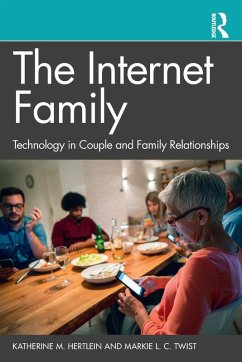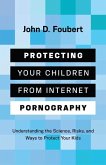Katherine M. Hertlein, Markie L. C. Twist
The Internet Family
Technology in Couple and Family Relationships
Katherine M. Hertlein, Markie L. C. Twist
The Internet Family
Technology in Couple and Family Relationships
- Broschiertes Buch
- Merkliste
- Auf die Merkliste
- Bewerten Bewerten
- Teilen
- Produkt teilen
- Produkterinnerung
- Produkterinnerung
In The Internet Family, Drs. Katherine Hertlein and Markie Twist provide a current and comprehensive look at the effects of technology on couple and family relationships. Beginning with an overview of the multifaceted ways in which technology impacts our relationships today, the authors discuss a wide range of topics pertinent to couple and family life. Chapters focus on issues such as online dating and infidelity, parenting and the Internet, video gaming, cyberbullying, and everyday usage of social and new media, before providing guidance on how the reader can successfully navigate the…mehr
Andere Kunden interessierten sich auch für
![What Parents Need to Know about Internet Pornography What Parents Need to Know about Internet Pornography]() Jajoza Connected SolutionsWhat Parents Need to Know about Internet Pornography13,99 €
Jajoza Connected SolutionsWhat Parents Need to Know about Internet Pornography13,99 €![Parents Guide to the Internet Parents Guide to the Internet]() Jay LaBonteParents Guide to the Internet22,99 €
Jay LaBonteParents Guide to the Internet22,99 €![Guide to Internet Love Guide to Internet Love]() R. De ChalonGuide to Internet Love13,99 €
R. De ChalonGuide to Internet Love13,99 €![The Making and Breaking of the Australian Family The Making and Breaking of the Australian Family]() Michael GildingThe Making and Breaking of the Australian Family53,99 €
Michael GildingThe Making and Breaking of the Australian Family53,99 €![The Ancient Egyptian Family The Ancient Egyptian Family]() Troy D. AllenThe Ancient Egyptian Family73,99 €
Troy D. AllenThe Ancient Egyptian Family73,99 €![Protecting Your Children from Internet Pornography Protecting Your Children from Internet Pornography]() John D FoubertProtecting Your Children from Internet Pornography13,99 €
John D FoubertProtecting Your Children from Internet Pornography13,99 €![The Psychology of Men in Context The Psychology of Men in Context]() Michael E. AddisThe Psychology of Men in Context69,99 €
Michael E. AddisThe Psychology of Men in Context69,99 €-
-
-
In The Internet Family, Drs. Katherine Hertlein and Markie Twist provide a current and comprehensive look at the effects of technology on couple and family relationships. Beginning with an overview of the multifaceted ways in which technology impacts our relationships today, the authors discuss a wide range of topics pertinent to couple and family life. Chapters focus on issues such as online dating and infidelity, parenting and the Internet, video gaming, cyberbullying, and everyday usage of social and new media, before providing guidance on how the reader can successfully navigate the advantages and risks that emerge from the use of specific technologies. An online appendix offers a range of assessments and practical tools for identifying Internet-related problems and solutions. A portion of the text is also devoted to the application of the Couple and Family Technology framework and how it can be effectively integrated into clinicians' current practice. Couple and family therapists will find this book highly informative, both to use in their own practice and for referring clients to as part of the treatment process.
Hinweis: Dieser Artikel kann nur an eine deutsche Lieferadresse ausgeliefert werden.
Hinweis: Dieser Artikel kann nur an eine deutsche Lieferadresse ausgeliefert werden.
Produktdetails
- Produktdetails
- Verlag: Routledge
- Seitenzahl: 334
- Erscheinungstermin: 29. Mai 2019
- Englisch
- Abmessung: 229mm x 152mm x 18mm
- Gewicht: 485g
- ISBN-13: 9781138478053
- ISBN-10: 1138478059
- Artikelnr.: 56933165
- Herstellerkennzeichnung
- Libri GmbH
- Europaallee 1
- 36244 Bad Hersfeld
- gpsr@libri.de
- Verlag: Routledge
- Seitenzahl: 334
- Erscheinungstermin: 29. Mai 2019
- Englisch
- Abmessung: 229mm x 152mm x 18mm
- Gewicht: 485g
- ISBN-13: 9781138478053
- ISBN-10: 1138478059
- Artikelnr.: 56933165
- Herstellerkennzeichnung
- Libri GmbH
- Europaallee 1
- 36244 Bad Hersfeld
- gpsr@libri.de
Katherine M. Hertlein, PhD, LMFT, is a Professor in the Couple and Family Therapy Program in the School of Medicine's Department of Psychiatry and Behavioral Health at the University of Nevada, Las Vegas, and has published eight books on couple and family therapy. Markie L. C. Twist, PhD, LMFT, LHMC, CSE, is the Program Coordinator of the Graduate Certificate in Sex Therapy and Professor of Human Development and Family Studies at the University of Wisconsin-Stout, Wisconsin.
ABOUT THE AUTHORS xvii
PREFACE xix
Purpose of the Book
Outline of Chapters
Key Terms
A Note on Timeliness
ACKNOWLEDGMENTS
SECTION 1 Tutorial on Technology and Relationships
Chapter 1 Couples, Families, and Technology
Technology Invasion
Prevalence of Technology in Our Lives
Mobile Connections by Device
The Rise of the Applications: Online Video Games
The Rise of the Applications: Social Networking
Effects of Technology on Our Individual Selves
Effects of Technology on Physical Well-Being
Media Misinformation
Sedentary Lifestyles
Sleep
Effects of Technology on Psychological Well-Being
Life Satisfaction
Technology and Our Work Lives
Projecting What's Next for Technology in Our Lives
What Does All of This Mean for Relationships?
The Pathology of Pathology
Our View-A Balanced Approach
Conclusion
References
Chapter 2 From Digiteris to Tweeps: Understanding Online Communication
Patterns
What Drives Patterns of Technology Use?
Theoretical Models of MotivationsApplied to Social Media Use
The Importance of Being in Sync
Relational Factors Influencing Social Media Use
The Desire for Social Capital
'Cuz You've Got . . . Personality (Disorders)?
The Only Thing to Fear Is Missing Out
Comparing Face-to-Face and Internet Communication Technologies
Self-Presentation
Me, My Selfie, and I
Self-Presentation in Couples
Self-Presentation in Families
Shared Data
Rituals and Everydayness
Emotional Intimacy
History-Gathering
Consent
Conclusion
References
Chapter 3 Virtual Impacts on Real-Time Individual, Couple, and Family
Developments
Technology Immersion Across Developmental Contexts
Individual Lifespan: Erikson Revisited
Children
Adolescence
Young Adulthood
Self-Authorship in a Relationally Authored (and Heterogenic) Environment
Ecological Life Cycle Models
Bronfenbrenner Revisited
Social Comparison With Peers à la Festinger
Taylor Revisited
Technology Use Across Relational Developmental Stages
Technology, Anxiety, and Distress (Oh My!)
You're Never Fully Dressed Without a Phone
Attachment to Technology: The Missing Link?
Technology: The Monkey on Your Back (And in Your Family?)
Technology, Attachment, and Romantic Relationships
Conclusion
References
Chapter 4 Family "Net"working
Digital Family Communication
Youth and Online Communication
Parenting in a Digital World
Parents and Online Communication
Technology Interference in Parenting
Technology and Adoption
Privacy, Technology, and Family Relationships
From Helicopter-Parents to Drone-Parents:
Surveillance, Spying, and Other Monitoring Strategies
Surveillance Habituation
Family Negotiation of the "Net"
Conclusion
References
Chapter 5 The iCouple
Common Couple Issues in a Digital Age
Survey Says
Just the Two of Us
An Affair to Delete
Social Media and Romantic Relationships
Texting and Romantic Relationships
I Spy With My Little "I": Surveillance in Couples
Developing Trust Online
Conclusion
References
Chapter 6 Relational Malware: Risks of Technology in Relationships
The Trouble With Tech
Risky Business
Privacy
Your Penetralia is Showing
Privacy Considerations: The People
Privacy Considerations: The Space
Crossing Boundaries in Unbounded Space (Spy-Berspace?)
Cyberbullying
Technology-Based Dating Violence
Sexting
"Sometimes It's Hard to Be a Woman"
Sweet Revenge?
Cyberstalking
Conclusion
References
SECTION 2 Rebooting Your Relationships
Chapter 7 What About the Internet Changes Our Relationships?
A Social Solution to a Social Problem
The Couple and Family Technology Framework
Theoretical Frameworks
The Flexibility of the CFT Framework
"Everybody's Doing It": Acceptability
"Who Are You?": Anonymity Online
Me and My Shadow: Accessibility
The Ultimate Cheap Date: Affordability
A World of Sims: Approximation
Accommodation
"I Didn't Technically Touch Them So It Doesn't Count": Ambiguity
The Couple and Family Technology Framework in Action
Conclusion
References
Chapter 8 Strengthening Roles, Rules, and Boundaries
Introduction
Roles
Rules
Boundaries
Conclusion
References
Chapter 9 Improving Relationship Launches, Runtime, and Crashes
Relational Intelligence in a Digital World
Relationship Formation
"To Swipe or Not to Swipe"
Being Facebook Official
First Comes Love, Then Comes Meeting
Relationship Maintenance
Development Across the Couple Lifespan
Technology's Contribution to Relationship Satisfaction
Intimacy Development in Relationships With and Without Technology
Building Intimacy Through Self-Disclosure
Relationship Termination
To Block or Not to Block
Conclusion
References
Chapter 10 Debugging Advanced Internet-Based Relational Problems
Decoding Technology and Relationship Error Messages
Out-of-Control Technology-Related Behaviors
Technophobia
Sexual Technologies
Video and Online Gaming
Relational Power-Ups
Relational Challenge Mode
Action Point: A Case of Out-of-Control Online Gaming Behaviors
What the Tech Do We Do?
You Have Nothing to Fear, but Fear Itself
Winning Over Video Gaming Issues
Managing Out-of-Control Technology-Related Behaviors
Conclusion
References
Chapter 11 Measuring Technology's Impact on Relational Life
Assessment of Internet Impact in Daily Life: The Chicken or the Egg?
My Problem Is You(Tube)
Measuring "Addictive"/Compulsive Internet Use
Measurement Tools
What's in a Name?
Measuring Online Sexual Behavior
The Rebirth of Slick: The Couple and Family Technology Assessment Revised
Conclusion
References
Chapter 12 Developing Your Personal Technology Integration Plan With the
Couple and Family Algorithm
Technology Integration Plan
1. Consider the Audience
2. Maximize the Benefits
3. Consider the Motivations
Integration Ideas for Structure (Roles, Rules, Boundaries)
Boundary Tip 1: Check Your Email-Don't Let Your Email Check You
Boundary Tip 2: Cover Your Private Parts (or Privacy Management)
Rule Tip 1: Develop a Rule for Your Family on Collective Privacy Management
Initiating Relationships
Rule Tip 1: Recognition of Gatekeeping in Online Dating
Rule Tip 2: Recognition of the "Eight As"
Maintaining Relationships
Intimacy Tip 1: Electronic Fantasy Dates
Intimacy Tip 2: Using Asynchronous Methods to Manage Conflict
Intimacy Tip 3: Using Synchronous
Methods to Obtain Support
Intimacy Tip 4: Ensure Online Friends Are Offline Friends as Well
Trust Tip 1: Recovering From Online Infidelity
Trust Tip 2: Managing Surveillance
Ending Relationships
Termination Tip 1: "Give Up The Ghost"
Termination Tip 2: Using the Benefits of the Internet to Structure
Interactions
Online Behavior and Children: Some Guidelines
Rule Tip 1: When Should My Child Be Granted a Cellphone?
Case in Point: A Tale of Two Kiddies
Rule Tip 2: Boundaries and Rules for Safeguarding Against Cyberbullying
Conclusion
References
INDEX
APPENDICES - ONLINE ONLY
[can be accessed at www.routledge.com/9781138478053]
Appendix A: Ecological Elements Questionnaire
Appendix B: General Technological Focused Genogram Questions
Appendix C: Couple and Family Technology Focused Genogram Questions
Appendix D: Questions for Consideration Across an Electronic Developmental
Lifespan
PREFACE xix
Purpose of the Book
Outline of Chapters
Key Terms
A Note on Timeliness
ACKNOWLEDGMENTS
SECTION 1 Tutorial on Technology and Relationships
Chapter 1 Couples, Families, and Technology
Technology Invasion
Prevalence of Technology in Our Lives
Mobile Connections by Device
The Rise of the Applications: Online Video Games
The Rise of the Applications: Social Networking
Effects of Technology on Our Individual Selves
Effects of Technology on Physical Well-Being
Media Misinformation
Sedentary Lifestyles
Sleep
Effects of Technology on Psychological Well-Being
Life Satisfaction
Technology and Our Work Lives
Projecting What's Next for Technology in Our Lives
What Does All of This Mean for Relationships?
The Pathology of Pathology
Our View-A Balanced Approach
Conclusion
References
Chapter 2 From Digiteris to Tweeps: Understanding Online Communication
Patterns
What Drives Patterns of Technology Use?
Theoretical Models of MotivationsApplied to Social Media Use
The Importance of Being in Sync
Relational Factors Influencing Social Media Use
The Desire for Social Capital
'Cuz You've Got . . . Personality (Disorders)?
The Only Thing to Fear Is Missing Out
Comparing Face-to-Face and Internet Communication Technologies
Self-Presentation
Me, My Selfie, and I
Self-Presentation in Couples
Self-Presentation in Families
Shared Data
Rituals and Everydayness
Emotional Intimacy
History-Gathering
Consent
Conclusion
References
Chapter 3 Virtual Impacts on Real-Time Individual, Couple, and Family
Developments
Technology Immersion Across Developmental Contexts
Individual Lifespan: Erikson Revisited
Children
Adolescence
Young Adulthood
Self-Authorship in a Relationally Authored (and Heterogenic) Environment
Ecological Life Cycle Models
Bronfenbrenner Revisited
Social Comparison With Peers à la Festinger
Taylor Revisited
Technology Use Across Relational Developmental Stages
Technology, Anxiety, and Distress (Oh My!)
You're Never Fully Dressed Without a Phone
Attachment to Technology: The Missing Link?
Technology: The Monkey on Your Back (And in Your Family?)
Technology, Attachment, and Romantic Relationships
Conclusion
References
Chapter 4 Family "Net"working
Digital Family Communication
Youth and Online Communication
Parenting in a Digital World
Parents and Online Communication
Technology Interference in Parenting
Technology and Adoption
Privacy, Technology, and Family Relationships
From Helicopter-Parents to Drone-Parents:
Surveillance, Spying, and Other Monitoring Strategies
Surveillance Habituation
Family Negotiation of the "Net"
Conclusion
References
Chapter 5 The iCouple
Common Couple Issues in a Digital Age
Survey Says
Just the Two of Us
An Affair to Delete
Social Media and Romantic Relationships
Texting and Romantic Relationships
I Spy With My Little "I": Surveillance in Couples
Developing Trust Online
Conclusion
References
Chapter 6 Relational Malware: Risks of Technology in Relationships
The Trouble With Tech
Risky Business
Privacy
Your Penetralia is Showing
Privacy Considerations: The People
Privacy Considerations: The Space
Crossing Boundaries in Unbounded Space (Spy-Berspace?)
Cyberbullying
Technology-Based Dating Violence
Sexting
"Sometimes It's Hard to Be a Woman"
Sweet Revenge?
Cyberstalking
Conclusion
References
SECTION 2 Rebooting Your Relationships
Chapter 7 What About the Internet Changes Our Relationships?
A Social Solution to a Social Problem
The Couple and Family Technology Framework
Theoretical Frameworks
The Flexibility of the CFT Framework
"Everybody's Doing It": Acceptability
"Who Are You?": Anonymity Online
Me and My Shadow: Accessibility
The Ultimate Cheap Date: Affordability
A World of Sims: Approximation
Accommodation
"I Didn't Technically Touch Them So It Doesn't Count": Ambiguity
The Couple and Family Technology Framework in Action
Conclusion
References
Chapter 8 Strengthening Roles, Rules, and Boundaries
Introduction
Roles
Rules
Boundaries
Conclusion
References
Chapter 9 Improving Relationship Launches, Runtime, and Crashes
Relational Intelligence in a Digital World
Relationship Formation
"To Swipe or Not to Swipe"
Being Facebook Official
First Comes Love, Then Comes Meeting
Relationship Maintenance
Development Across the Couple Lifespan
Technology's Contribution to Relationship Satisfaction
Intimacy Development in Relationships With and Without Technology
Building Intimacy Through Self-Disclosure
Relationship Termination
To Block or Not to Block
Conclusion
References
Chapter 10 Debugging Advanced Internet-Based Relational Problems
Decoding Technology and Relationship Error Messages
Out-of-Control Technology-Related Behaviors
Technophobia
Sexual Technologies
Video and Online Gaming
Relational Power-Ups
Relational Challenge Mode
Action Point: A Case of Out-of-Control Online Gaming Behaviors
What the Tech Do We Do?
You Have Nothing to Fear, but Fear Itself
Winning Over Video Gaming Issues
Managing Out-of-Control Technology-Related Behaviors
Conclusion
References
Chapter 11 Measuring Technology's Impact on Relational Life
Assessment of Internet Impact in Daily Life: The Chicken or the Egg?
My Problem Is You(Tube)
Measuring "Addictive"/Compulsive Internet Use
Measurement Tools
What's in a Name?
Measuring Online Sexual Behavior
The Rebirth of Slick: The Couple and Family Technology Assessment Revised
Conclusion
References
Chapter 12 Developing Your Personal Technology Integration Plan With the
Couple and Family Algorithm
Technology Integration Plan
1. Consider the Audience
2. Maximize the Benefits
3. Consider the Motivations
Integration Ideas for Structure (Roles, Rules, Boundaries)
Boundary Tip 1: Check Your Email-Don't Let Your Email Check You
Boundary Tip 2: Cover Your Private Parts (or Privacy Management)
Rule Tip 1: Develop a Rule for Your Family on Collective Privacy Management
Initiating Relationships
Rule Tip 1: Recognition of Gatekeeping in Online Dating
Rule Tip 2: Recognition of the "Eight As"
Maintaining Relationships
Intimacy Tip 1: Electronic Fantasy Dates
Intimacy Tip 2: Using Asynchronous Methods to Manage Conflict
Intimacy Tip 3: Using Synchronous
Methods to Obtain Support
Intimacy Tip 4: Ensure Online Friends Are Offline Friends as Well
Trust Tip 1: Recovering From Online Infidelity
Trust Tip 2: Managing Surveillance
Ending Relationships
Termination Tip 1: "Give Up The Ghost"
Termination Tip 2: Using the Benefits of the Internet to Structure
Interactions
Online Behavior and Children: Some Guidelines
Rule Tip 1: When Should My Child Be Granted a Cellphone?
Case in Point: A Tale of Two Kiddies
Rule Tip 2: Boundaries and Rules for Safeguarding Against Cyberbullying
Conclusion
References
INDEX
APPENDICES - ONLINE ONLY
[can be accessed at www.routledge.com/9781138478053]
Appendix A: Ecological Elements Questionnaire
Appendix B: General Technological Focused Genogram Questions
Appendix C: Couple and Family Technology Focused Genogram Questions
Appendix D: Questions for Consideration Across an Electronic Developmental
Lifespan
ABOUT THE AUTHORS xvii
PREFACE xix
Purpose of the Book
Outline of Chapters
Key Terms
A Note on Timeliness
ACKNOWLEDGMENTS
SECTION 1 Tutorial on Technology and Relationships
Chapter 1 Couples, Families, and Technology
Technology Invasion
Prevalence of Technology in Our Lives
Mobile Connections by Device
The Rise of the Applications: Online Video Games
The Rise of the Applications: Social Networking
Effects of Technology on Our Individual Selves
Effects of Technology on Physical Well-Being
Media Misinformation
Sedentary Lifestyles
Sleep
Effects of Technology on Psychological Well-Being
Life Satisfaction
Technology and Our Work Lives
Projecting What's Next for Technology in Our Lives
What Does All of This Mean for Relationships?
The Pathology of Pathology
Our View-A Balanced Approach
Conclusion
References
Chapter 2 From Digiteris to Tweeps: Understanding Online Communication
Patterns
What Drives Patterns of Technology Use?
Theoretical Models of MotivationsApplied to Social Media Use
The Importance of Being in Sync
Relational Factors Influencing Social Media Use
The Desire for Social Capital
'Cuz You've Got . . . Personality (Disorders)?
The Only Thing to Fear Is Missing Out
Comparing Face-to-Face and Internet Communication Technologies
Self-Presentation
Me, My Selfie, and I
Self-Presentation in Couples
Self-Presentation in Families
Shared Data
Rituals and Everydayness
Emotional Intimacy
History-Gathering
Consent
Conclusion
References
Chapter 3 Virtual Impacts on Real-Time Individual, Couple, and Family
Developments
Technology Immersion Across Developmental Contexts
Individual Lifespan: Erikson Revisited
Children
Adolescence
Young Adulthood
Self-Authorship in a Relationally Authored (and Heterogenic) Environment
Ecological Life Cycle Models
Bronfenbrenner Revisited
Social Comparison With Peers à la Festinger
Taylor Revisited
Technology Use Across Relational Developmental Stages
Technology, Anxiety, and Distress (Oh My!)
You're Never Fully Dressed Without a Phone
Attachment to Technology: The Missing Link?
Technology: The Monkey on Your Back (And in Your Family?)
Technology, Attachment, and Romantic Relationships
Conclusion
References
Chapter 4 Family "Net"working
Digital Family Communication
Youth and Online Communication
Parenting in a Digital World
Parents and Online Communication
Technology Interference in Parenting
Technology and Adoption
Privacy, Technology, and Family Relationships
From Helicopter-Parents to Drone-Parents:
Surveillance, Spying, and Other Monitoring Strategies
Surveillance Habituation
Family Negotiation of the "Net"
Conclusion
References
Chapter 5 The iCouple
Common Couple Issues in a Digital Age
Survey Says
Just the Two of Us
An Affair to Delete
Social Media and Romantic Relationships
Texting and Romantic Relationships
I Spy With My Little "I": Surveillance in Couples
Developing Trust Online
Conclusion
References
Chapter 6 Relational Malware: Risks of Technology in Relationships
The Trouble With Tech
Risky Business
Privacy
Your Penetralia is Showing
Privacy Considerations: The People
Privacy Considerations: The Space
Crossing Boundaries in Unbounded Space (Spy-Berspace?)
Cyberbullying
Technology-Based Dating Violence
Sexting
"Sometimes It's Hard to Be a Woman"
Sweet Revenge?
Cyberstalking
Conclusion
References
SECTION 2 Rebooting Your Relationships
Chapter 7 What About the Internet Changes Our Relationships?
A Social Solution to a Social Problem
The Couple and Family Technology Framework
Theoretical Frameworks
The Flexibility of the CFT Framework
"Everybody's Doing It": Acceptability
"Who Are You?": Anonymity Online
Me and My Shadow: Accessibility
The Ultimate Cheap Date: Affordability
A World of Sims: Approximation
Accommodation
"I Didn't Technically Touch Them So It Doesn't Count": Ambiguity
The Couple and Family Technology Framework in Action
Conclusion
References
Chapter 8 Strengthening Roles, Rules, and Boundaries
Introduction
Roles
Rules
Boundaries
Conclusion
References
Chapter 9 Improving Relationship Launches, Runtime, and Crashes
Relational Intelligence in a Digital World
Relationship Formation
"To Swipe or Not to Swipe"
Being Facebook Official
First Comes Love, Then Comes Meeting
Relationship Maintenance
Development Across the Couple Lifespan
Technology's Contribution to Relationship Satisfaction
Intimacy Development in Relationships With and Without Technology
Building Intimacy Through Self-Disclosure
Relationship Termination
To Block or Not to Block
Conclusion
References
Chapter 10 Debugging Advanced Internet-Based Relational Problems
Decoding Technology and Relationship Error Messages
Out-of-Control Technology-Related Behaviors
Technophobia
Sexual Technologies
Video and Online Gaming
Relational Power-Ups
Relational Challenge Mode
Action Point: A Case of Out-of-Control Online Gaming Behaviors
What the Tech Do We Do?
You Have Nothing to Fear, but Fear Itself
Winning Over Video Gaming Issues
Managing Out-of-Control Technology-Related Behaviors
Conclusion
References
Chapter 11 Measuring Technology's Impact on Relational Life
Assessment of Internet Impact in Daily Life: The Chicken or the Egg?
My Problem Is You(Tube)
Measuring "Addictive"/Compulsive Internet Use
Measurement Tools
What's in a Name?
Measuring Online Sexual Behavior
The Rebirth of Slick: The Couple and Family Technology Assessment Revised
Conclusion
References
Chapter 12 Developing Your Personal Technology Integration Plan With the
Couple and Family Algorithm
Technology Integration Plan
1. Consider the Audience
2. Maximize the Benefits
3. Consider the Motivations
Integration Ideas for Structure (Roles, Rules, Boundaries)
Boundary Tip 1: Check Your Email-Don't Let Your Email Check You
Boundary Tip 2: Cover Your Private Parts (or Privacy Management)
Rule Tip 1: Develop a Rule for Your Family on Collective Privacy Management
Initiating Relationships
Rule Tip 1: Recognition of Gatekeeping in Online Dating
Rule Tip 2: Recognition of the "Eight As"
Maintaining Relationships
Intimacy Tip 1: Electronic Fantasy Dates
Intimacy Tip 2: Using Asynchronous Methods to Manage Conflict
Intimacy Tip 3: Using Synchronous
Methods to Obtain Support
Intimacy Tip 4: Ensure Online Friends Are Offline Friends as Well
Trust Tip 1: Recovering From Online Infidelity
Trust Tip 2: Managing Surveillance
Ending Relationships
Termination Tip 1: "Give Up The Ghost"
Termination Tip 2: Using the Benefits of the Internet to Structure
Interactions
Online Behavior and Children: Some Guidelines
Rule Tip 1: When Should My Child Be Granted a Cellphone?
Case in Point: A Tale of Two Kiddies
Rule Tip 2: Boundaries and Rules for Safeguarding Against Cyberbullying
Conclusion
References
INDEX
APPENDICES - ONLINE ONLY
[can be accessed at www.routledge.com/9781138478053]
Appendix A: Ecological Elements Questionnaire
Appendix B: General Technological Focused Genogram Questions
Appendix C: Couple and Family Technology Focused Genogram Questions
Appendix D: Questions for Consideration Across an Electronic Developmental
Lifespan
PREFACE xix
Purpose of the Book
Outline of Chapters
Key Terms
A Note on Timeliness
ACKNOWLEDGMENTS
SECTION 1 Tutorial on Technology and Relationships
Chapter 1 Couples, Families, and Technology
Technology Invasion
Prevalence of Technology in Our Lives
Mobile Connections by Device
The Rise of the Applications: Online Video Games
The Rise of the Applications: Social Networking
Effects of Technology on Our Individual Selves
Effects of Technology on Physical Well-Being
Media Misinformation
Sedentary Lifestyles
Sleep
Effects of Technology on Psychological Well-Being
Life Satisfaction
Technology and Our Work Lives
Projecting What's Next for Technology in Our Lives
What Does All of This Mean for Relationships?
The Pathology of Pathology
Our View-A Balanced Approach
Conclusion
References
Chapter 2 From Digiteris to Tweeps: Understanding Online Communication
Patterns
What Drives Patterns of Technology Use?
Theoretical Models of MotivationsApplied to Social Media Use
The Importance of Being in Sync
Relational Factors Influencing Social Media Use
The Desire for Social Capital
'Cuz You've Got . . . Personality (Disorders)?
The Only Thing to Fear Is Missing Out
Comparing Face-to-Face and Internet Communication Technologies
Self-Presentation
Me, My Selfie, and I
Self-Presentation in Couples
Self-Presentation in Families
Shared Data
Rituals and Everydayness
Emotional Intimacy
History-Gathering
Consent
Conclusion
References
Chapter 3 Virtual Impacts on Real-Time Individual, Couple, and Family
Developments
Technology Immersion Across Developmental Contexts
Individual Lifespan: Erikson Revisited
Children
Adolescence
Young Adulthood
Self-Authorship in a Relationally Authored (and Heterogenic) Environment
Ecological Life Cycle Models
Bronfenbrenner Revisited
Social Comparison With Peers à la Festinger
Taylor Revisited
Technology Use Across Relational Developmental Stages
Technology, Anxiety, and Distress (Oh My!)
You're Never Fully Dressed Without a Phone
Attachment to Technology: The Missing Link?
Technology: The Monkey on Your Back (And in Your Family?)
Technology, Attachment, and Romantic Relationships
Conclusion
References
Chapter 4 Family "Net"working
Digital Family Communication
Youth and Online Communication
Parenting in a Digital World
Parents and Online Communication
Technology Interference in Parenting
Technology and Adoption
Privacy, Technology, and Family Relationships
From Helicopter-Parents to Drone-Parents:
Surveillance, Spying, and Other Monitoring Strategies
Surveillance Habituation
Family Negotiation of the "Net"
Conclusion
References
Chapter 5 The iCouple
Common Couple Issues in a Digital Age
Survey Says
Just the Two of Us
An Affair to Delete
Social Media and Romantic Relationships
Texting and Romantic Relationships
I Spy With My Little "I": Surveillance in Couples
Developing Trust Online
Conclusion
References
Chapter 6 Relational Malware: Risks of Technology in Relationships
The Trouble With Tech
Risky Business
Privacy
Your Penetralia is Showing
Privacy Considerations: The People
Privacy Considerations: The Space
Crossing Boundaries in Unbounded Space (Spy-Berspace?)
Cyberbullying
Technology-Based Dating Violence
Sexting
"Sometimes It's Hard to Be a Woman"
Sweet Revenge?
Cyberstalking
Conclusion
References
SECTION 2 Rebooting Your Relationships
Chapter 7 What About the Internet Changes Our Relationships?
A Social Solution to a Social Problem
The Couple and Family Technology Framework
Theoretical Frameworks
The Flexibility of the CFT Framework
"Everybody's Doing It": Acceptability
"Who Are You?": Anonymity Online
Me and My Shadow: Accessibility
The Ultimate Cheap Date: Affordability
A World of Sims: Approximation
Accommodation
"I Didn't Technically Touch Them So It Doesn't Count": Ambiguity
The Couple and Family Technology Framework in Action
Conclusion
References
Chapter 8 Strengthening Roles, Rules, and Boundaries
Introduction
Roles
Rules
Boundaries
Conclusion
References
Chapter 9 Improving Relationship Launches, Runtime, and Crashes
Relational Intelligence in a Digital World
Relationship Formation
"To Swipe or Not to Swipe"
Being Facebook Official
First Comes Love, Then Comes Meeting
Relationship Maintenance
Development Across the Couple Lifespan
Technology's Contribution to Relationship Satisfaction
Intimacy Development in Relationships With and Without Technology
Building Intimacy Through Self-Disclosure
Relationship Termination
To Block or Not to Block
Conclusion
References
Chapter 10 Debugging Advanced Internet-Based Relational Problems
Decoding Technology and Relationship Error Messages
Out-of-Control Technology-Related Behaviors
Technophobia
Sexual Technologies
Video and Online Gaming
Relational Power-Ups
Relational Challenge Mode
Action Point: A Case of Out-of-Control Online Gaming Behaviors
What the Tech Do We Do?
You Have Nothing to Fear, but Fear Itself
Winning Over Video Gaming Issues
Managing Out-of-Control Technology-Related Behaviors
Conclusion
References
Chapter 11 Measuring Technology's Impact on Relational Life
Assessment of Internet Impact in Daily Life: The Chicken or the Egg?
My Problem Is You(Tube)
Measuring "Addictive"/Compulsive Internet Use
Measurement Tools
What's in a Name?
Measuring Online Sexual Behavior
The Rebirth of Slick: The Couple and Family Technology Assessment Revised
Conclusion
References
Chapter 12 Developing Your Personal Technology Integration Plan With the
Couple and Family Algorithm
Technology Integration Plan
1. Consider the Audience
2. Maximize the Benefits
3. Consider the Motivations
Integration Ideas for Structure (Roles, Rules, Boundaries)
Boundary Tip 1: Check Your Email-Don't Let Your Email Check You
Boundary Tip 2: Cover Your Private Parts (or Privacy Management)
Rule Tip 1: Develop a Rule for Your Family on Collective Privacy Management
Initiating Relationships
Rule Tip 1: Recognition of Gatekeeping in Online Dating
Rule Tip 2: Recognition of the "Eight As"
Maintaining Relationships
Intimacy Tip 1: Electronic Fantasy Dates
Intimacy Tip 2: Using Asynchronous Methods to Manage Conflict
Intimacy Tip 3: Using Synchronous
Methods to Obtain Support
Intimacy Tip 4: Ensure Online Friends Are Offline Friends as Well
Trust Tip 1: Recovering From Online Infidelity
Trust Tip 2: Managing Surveillance
Ending Relationships
Termination Tip 1: "Give Up The Ghost"
Termination Tip 2: Using the Benefits of the Internet to Structure
Interactions
Online Behavior and Children: Some Guidelines
Rule Tip 1: When Should My Child Be Granted a Cellphone?
Case in Point: A Tale of Two Kiddies
Rule Tip 2: Boundaries and Rules for Safeguarding Against Cyberbullying
Conclusion
References
INDEX
APPENDICES - ONLINE ONLY
[can be accessed at www.routledge.com/9781138478053]
Appendix A: Ecological Elements Questionnaire
Appendix B: General Technological Focused Genogram Questions
Appendix C: Couple and Family Technology Focused Genogram Questions
Appendix D: Questions for Consideration Across an Electronic Developmental
Lifespan








